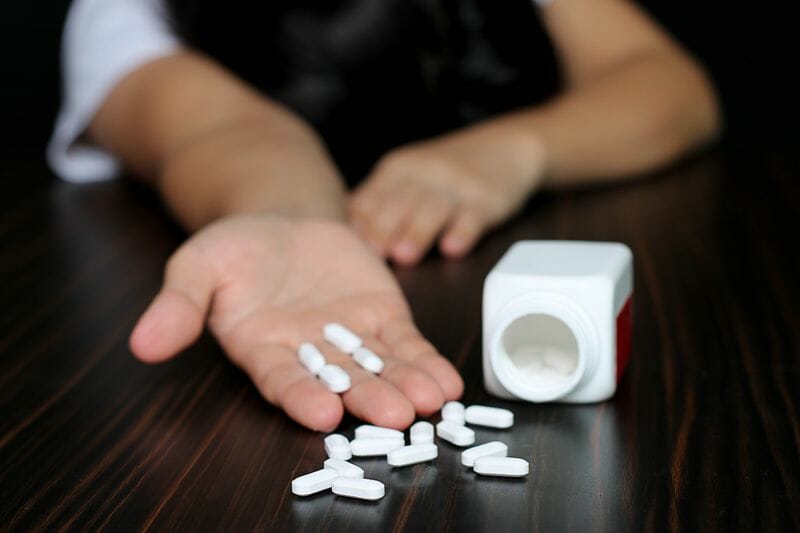DMT is hallucinogenic. It is derived from an alkaloid that naturally occurs in the natural world. Using DMT results in ‘brief and intense psychedelic effects,’ that people often describe as a trip. The drug is known for its fast-acting, short highs. Whilst the effects of the drug – like with any psychedelic – will be different for each user, DMT is taken for its mind-altering properties.
If DMT acts as a hallucinogen, then how can we differentiate it from substances like LSD, or magic mushrooms? Where does DMT come from? How long can you expect a DMT trip to last? How do you use DMT, and does the drug have any addictive potential? Finally, is there a way that DMT can actually treat addiction?
DMT: The history
DMT, a centuries-old substance used in religious rituals in South America, gained European exposure during the fifteenth-century colonial expansion. Friar Ramon Pane’s 1498 manuscript on Hispaniola may be the earliest European record of DMT use.
Synthetic DMT was developed by Richard Manske in 1931, and its natural occurrence in plants was discovered by Oswaldo Gocalves de Lima in 1946. The psychedelic potential was confirmed in 1956, leading to its control under the UK’s Misuse of Drugs Act by 1971.
Since its Western introduction, DMT has intrigued both users and scientists, straddling the realms of science and spirituality. Ongoing research and a modern shamanic ritual reflect its enduring spiritual connection. Influential figures like Rick Strausmann have conducted extensive experiments and proposed DMT’s link to the human soul.
Strausmann’s 2000 book, “DMT: The Spirit Molecule,” explores DMT’s presence in the body and its potential connection to the pineal gland. This work has inspired “DMT retreats” for psychological healing, with a 2010 documentary adaptation sparking debates on the ethics of promoting psychedelic drugs.
Alternative names for DMT
Most substances are referred to with multiple names. There are the:
- Scientific or chemical names (which often have an abbreviation);
- and the colloquial terms or street names
In this case, the scientific name is N,N-Dimethyltryptamine. This name is typically abbreviated to DMT. There are a range of street names for DMT, including:
- Ayahuasca
- The Businessman’s Trip
- Dimitri
- The Rogan
- The Spirit Molecule
- The businessman’s trip

You may find that street names for substances could be different in your area. This is because street names or slang are often part of a local dialect. Whilst some names are more widespread in drug culture (for instance, ‘Acid’ as an alternate name for LSD), others can be more specific to local areas. For this reason, it is very important to clarify what substances you may share, buy, or sell to reduce the risk of being lost in slang translation. Clear language is important, as it lets you stay aware of what you are using.
DMT: What is it?
N,N-Dimethyltryptamine has hallucinogenic properties. But unlike some other substances, DMT isn’t necessarily synthetically produced. DMT is an ‘indole alkaloid’ that is found across different life forms. This means that it is a naturally occurring compound that can be identified in both the bodies of animals and within plant matter.
Where is DMT found?
DMT is found in a range of plants, including:
- Phalaris (a type of flowering grass)
- Delosperma (a type of flowered, succulent plant)
- Acacia (a type of tree or shrub)
- Desmodium (a pink flowering plant with long stems)
- Mimosa (a leafy, perennial flowering plant)
- Virola (a type of tree native to the South American rainforest)
- Psychotria (a perennial shrub related to the coffee plant)
It has also been located within bergamot, a type of citrus plant. The presence of DMT in the mimosa tenuiflora plant has been associated with livestock poisoning. Interestingly, however, the use of DMT in humans is rarely linked with physical toxicity. One study claims that there has only been one case of DMT poisoning ‘to our knowledge,’ following recreational use.’
Preparing: Ayahuasca: ‘The tea’
DMT is also associated with ayahuasca.
Ayahuasca is a brewed concoction or psychoactive drink made from plant matter. Typically, the drink is made from two plants: the banisteriopsis caapi and the psychotria viridis shrub. The substance is a ‘decoction’. This means that it is a concentrated liquid produced by boiling different parts of the banisteriopsis caapi and psychotria viridis plants.
Once boiled, the liquid can be consumed by drinking. In a ritual setting, drinking this brew of plant-tea is considered to be a kind of purging. The purging is typically linked to use for wellbeing purposes, including healing. For that reason, ayahuasca is sometimes also known as ‘the purge.’
Ayahuasca preparations are sometimes associated with alternate plants, such as chacruna. Different plants are chosen in order to deliver specific psychoactive effects fit for a given ritual context. This practice has been linked to the heritage of First Nations peoples in different areas of South America..
DMT: Mode of use
In the form of ayahuasca, DMT can be ingested by drinking the brewed liquid.
However, this is not the only way that DMT can be used. It has a range of modes of use, including, smoking, injecting and snorting.
- sharps injuries
- damage to veins
- risk of infection
- risk of contracting bloodborne viruses such as HIV/AIDS and Hepatitis
DMT Dosage
Because DMT is regularly mixed with other substances, it is very difficult to control the strength of a dosage. This means that your first high may be very different to your second, for example, because the batch of DMT, ayahuasca or changa you use may have different concentrations of Dimethyltryptamine inside them.
The strength of dosage effects a myriad of things, including:
- the general feeling of the high or ‘trip’
- how long it takes for the high to affect you
- how long the high will last for
- how serious potential effects related to DMT use may be
How serious are the effects of DMT?
The Law
DMT has been categorised as a Class A drug under UK drug legislation. Under the Misuse of Drugs Act (1971), Class A are considered to be amongst the most dangerous substances on the market. This is reflected in the associated legal penalties.
If you are found to be involved in the production or supply of Class A drugs (including DMT), you could face:
- up to life in prison
- an unlimited fine
- or in some instances, both.
The effects of DMT
Hallucinogens are primarily taken for their psychedelic properties. That means, for the most part, people using DMT are seeking the psychological effects of psychedelic high. These effects may involve:
- sudden changes in perception of time (feeling as though you – or everything around you – is suddenly at a rapid or crawling pace)
- sudden changes in perception of movement (you may feel disconnected from your body)
- out of body experiences
- hallucinations (these are often auditory and visual and can be pleasant or unpleasant)
- blurred or double vision
- sensory perception becomes more intense (colours are brighter, sounds sound different to usual)
Whilst DMT’s psychoactive effects are often its main draw for users, this does not mean that it does not affect the body at all. If you use DMT, you may notice the following sensations in your body:
- increased heart rate
- arrhythmia (irregular breathing)
- increased blood pressure
- nausea
- being sick
The Risks of DMT
The risks of DMT are hotly debated. Whilst DMT is a Class A substance in the UK, there are still discussions over the risks of DMT, particularly in connection with its potentially addictive nature.
Research on DMT has not been able to identify any addictive compounds present. This means, that unlike other substances like cocaine or heroin, using DMT is not typically associated with the development of dependency or physical withdrawals. This means that the addiction potential for DMT is very low – or even non-existent.
However, this does not mean that DMT is a drug without risks. Like with all substances, it is not possible to determine a safe level of use. This is due to a range of factors, such as:
- we cannot determine how we will react to a substance until we have used it
- it is not certain that we will react the same way each time we use a substance
- we do not know how substances will affect pre existing physical health conditions
- we do not know how substances will affect pre existing mental health conditions
- we cannot know for sure what a substance contains
- we cannot know for sure the strength of a substance
- we cannot know for sure how a substance will interact with other substances we use (prescription or otherwise)
Even with a decreased potential for addiction, DMT does still come with some risks. These can include:
- unpleasant hallucinations
- paranoia
- symptoms of psychosis
- trigger flashbacks
- inhibition can lead to harm (either intentionally or accidentally)
The key concerns here are regarding immediate safety and long-term mental health.
Risks to immediate safety
Hallucinogens pose a threat to immediate safety. This is because potent hallucinations mixed with lowered inhibitions may mean our ability to judge a situation can be reduced. Hallucinations can be very vivid. If we feel that something is real, we are likely to respond to it as though it exists.
This means it would not be unlikely to respond to a perceived danger in an unsafe manner. Command hallucinations – hearing voices that tell you to act in certain ways – may be a factor here. However, it is possible that any hallucination may put you at risk. This could include becoming violent towards yourself or others or becoming in danger of your surroundings, such as traffic, railways or bodies of water.
There is also the risk of operating heavy machinery, whether driving a vehicle or at work. Using drugs can reduce your inhibitions and make such activities significantly more risky.
Risks to mental health
There are instances where, following the use of psychedelics, individuals have found that the symptoms of the high have continued. This is a type of substance-induced psychosis that is often referred to as hallucinogen-persisting perception disorder (HPPD).
HPPD is described as ‘a long-lasting condition characterised by spontaneous recurrence of visual disturbances reminiscent of acute hallucinogenic intoxication.’ People experiencing HPDD have reported encountering
- flashes of colour
- objects in peripheral vision
- visions of specific shapes
- ‘trailing perception of moving objects’
In some cases, these symptoms can be present for years.
A second risk to mental health is the heightened likelihood of flashbacks. Studies into hallucinogen use indicate that anywhere between 5% and 50% of people experienced flashbacks at some point following their drug use.
This can be particularly risky in individuals who have experienced some trauma. Flashbacks can cause intense distress and lead to the general worsening of mental health over time.
DMT: The chemistry
In the scientific world, DMT is known as N,N-Dimethyltryptamine. Research into the compound’s psychoactive effects is yet to conclude how DMT’s effects occur in the brain, leading to one research team claiming that ‘the biological function of DMT remains a mystery.’
One hypothesis suggests that DMT works on the serotonin system – in a manner similar to other hallucinogens. However, this has been called into question by the presence of effects not typically associated with serotonin, such as tremors and involuntary muscle movements.
Another theory is that DMT itself works as a neurotransmitter after entering the brain, acting by ‘exert[ing] a signalling function in regions of the [Central Nervous System] CNS.’
There are a lot of theories about the potential utility of DMT in psychiatric medicine. But whilst we are still not fully aware of the function of DMT, there may still be undiscovered risks around this type of use.
Can DMT treat addiction?
Throughout DMT’s history, its potential to both cause and cure addiction has been explored. Bill Wilson, a founder of Alcoholics Anonymous, experimented with LSD to overcome alcoholism, attributing a ‘spiritual awakening’ to psychedelics. Studies in South America show discontinued drug use after ayahuasca consumption, suggesting potential for psychedelic-based treatments.
Despite positive outcomes, the use of DMT in psychiatric treatment lacks thorough research. While hallucinogen-assisted therapy may benefit some, the intensity of psychedelic effects raises concerns about exacerbating existing issues. Traditional rehab centres often avoid psychedelic therapy, but alternative centres worldwide offer DMT-based treatments, gaining popularity in the US and specific European regions.
Debates persist about the effects of DMT, with some describing it as a ‘Clockwork Orange-like horror show.’ However, others note its potential as a ‘brutal mirror,’ revealing insights yet to be fully understood.
Getting Help for Your DMT Addiction

Key Steps in DMT Addiction Treatment:
- Consultation with professionals: Speak with a GP or addiction specialist to understand your situation and explore treatment options tailored to your needs.
- Comprehensive addiction treatment: The process involves detoxification (detox), therapy, potentially in a residential rehabilitation facility, and aftercare. Therapy addresses negative thought patterns and behaviours that contribute to addiction.
- Detox: Detox is essential to cleanse the system before engaging in therapy. DMT detox focuses on psychological withdrawal symptoms such as cravings, anxiety, depression, insomnia, hallucinations, and psychosis.
- Withdrawal Effects: The duration of DMT withdrawal syndrome varies based on addiction duration, dosages, administration methods, and the user’s overall condition. While symptoms may peak days after the last dose, some may experience post-acute withdrawal syndrome (PAWS) lasting months or years, requiring specialist care.
Remember, addiction treatment is a comprehensive process aimed at reshaping negative behaviours and fostering a positive, abstinent life. Aftercare, often for up to a year, is crucial to ensuring a successful and sustained recovery.
No matter where you live, there is a drug rehab center that can help you overcome your addiction. We'll help you find it.
Select a County









